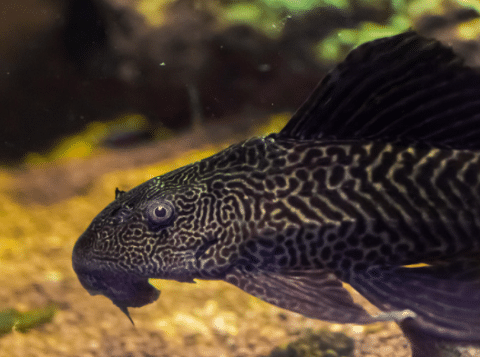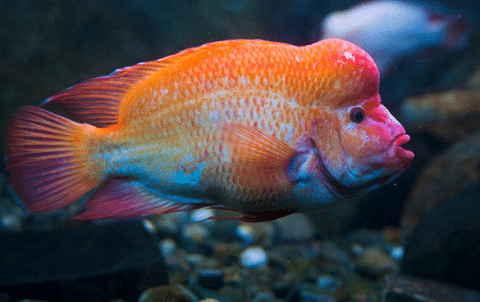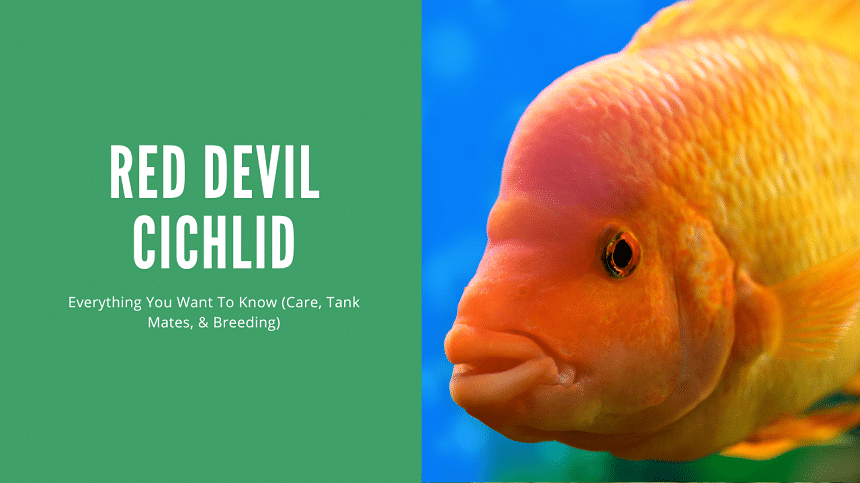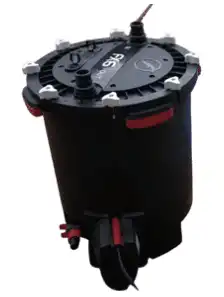Thank you for visiting! By the way… any links on this page that lead to products on Amazon and other stores/partners are affiliate links Aquarium Store Depot earns a commission if you make a purchase.
Are you looking for a large, impressive fish with great color and heaps of personality? The red devil cichlid could be the perfect choice for you!
However, keeping large aggressive fish is not for everyone, and arming yourself with the right knowledge is key to your success in the long run. That’s why I’ve decided to write this comprehensive guide to red devil cichlid care. We’ll cover everything you need to know from tank setup to diet and even breeding.
So let’s get started!
Key Takeaways
- The red devil cichlid is a large, aggressive freshwater fish that needs a large tank
- They grow over 12 inches with males being larger
- They make wonderful pets for experienced fish keepers, but they are known to attack other fish and even bite human hands
- It is easiest to keep the red devil cichlid in its own tank without other fish
Fish Species Overview
| Scientific Name | Amphilophus labiatus |
| Common Names | Red devil cichlid |
| Family | Cichlidae |
| Origin | Nicaragua, Central America |
| Diet | Omnivore |
| Care Level | Moderate |
| Activity | High |
| Lifespan | 10 to 12 years |
| Temperament | Aggressive |
| Tank Level | All levels |
| Minimum Tank Size | 75 gallons |
| Temperature Range | 70 – 78 °F |
| Water Hardness | 6 – 25 dGH |
| pH Range | 6.0 – 8.0 |
| Filtration/Water Flow | Moderate to high |
| Water Type | Freshwater |
| Breeding | Egg Layer |
| Difficulty to Breed | Moderate |
| Compatibility | Limited, Species-only tank |
| OK, for Planted Tanks? | No |
Origins
The red devil cichlid is native to Lake Managua and Lake Nicaragua, two large freshwater lakes in the Central American country of Nicaragua. These Nicaraguan lakes provide naturally warm waters throughout the year.
These feisty fish have been introduced to a few places in the world, and wild populations exist in Florida and Hawaii today.
Appearance
The red devil cichlid is a large, attractive freshwater fish that comes in a range of colors. Wild fish are often gray or dark brown but specimens in the aquarium trade stand out with white, yellow, orange, and even bright red shades.

They may be a single color or a combination, with many fish having attractive spots and patterns. Many specimens change color as they mature, so a full-grown adult may look quite different from when you first bought it.
Male red devil fish are larger than females and develop a pronounced bump (nuchal hump) above their heads. Red devils are characterized by their large, thick lips, although this feature is much more pronounced in wild-caught fish.
Red devil cichlids have large dorsal and anal fins that end in a sharp point, sometimes extending to the end of their fan-shaped tails.
The red devil cichlid is easily confused with another popular Central American species known as the Midas Cichlid (Amphilophus citrinellus). However, the red devil grows larger and tends to have thicker lips.
How Big Can They Get?
The red devil cichlid is a large, heavily built fish. Adults can measure 12 to 15 inches when fully grown, and males are the larger sex.
Red devil cichlids are often sold at just an inch or two, but they grow to reach adult size in just three years or so.
How Long Do They Live?
The red devil cichlid can live for over ten years with good care. Their average lifespan is about 10 to 12 years, making them a similar commitment to the average dog.
These fish will live longest if given plenty of tank space, high water quality, and a healthy, balanced diet.
What Do They Eat?
Feeding your red devil cichlid is one of the easiest aspects of its care. These true omnivores eat insect larvae, snails, small fish, and plant material in nature.
Captive specimens are not fussy, and high-quality cichlid pellets are the best option for their daily needs, although young red devil cichlids will eagerly accept tropical fish flakes.
Ron is an African Cichlid breeder with over 25 years in experience who created a line of food that is well balanced. A great option when you can't use frozen foods.
Supplement the red devil cichlid diet with the following foods to improve their general condition:
- Brine shrimp
- Bloodworms
- Peas
- Lettuce
- Spinach
Live Foods
Live foods provide a great natural source of nutrition for your red devil cichlid. These fish regularly hunt live prey in nature, so they certainly have that killer instinct. Live foods like earthworms, crickets, and cockroaches are great choices.
How Often and How Much to Feed them
Feed your red devil cichlid at least twice each day, providing only as much food as your fish will eat. Remove any uneaten food before it spoils in your tank water.
Red devil cichlids can be very excitable around mealtimes, and they will often crash into the hood of your aquarium when taking food from the surface. Make sure your lid is securely fitted and solidly built.
Weigh down lightweight hoods to keep them securely in place, and take care when feeding these fish, as an accidental bite could be pretty painful.
Temperament and Behavior
The red devil cichlid is an aggressive fish, and they aren’t called devils for nothing! However, these colorful cichlids usually make wonderful pets that love to interact with their owners.
Nevertheless, many specimens will bite the hand that feeds them, and larger fish can easily draw blood. In extreme cases, you may need to use a divider to keep your fish to one side when performing tank maintenance.
Red devils are not fish you can add to a community aquarium. These guys need careful planning and a tank that is designed around their needs. However, it is possible to keep them with some other fish types.
Continue reading to learn about the best red devil cichlid tank mates.
Red Devil Cichlid Tank Mates
Choosing tank mates for your red devil cichlid is challenging because these fish are just so aggressive. It is best to keep them in a species-only tank because they have such great personalities that you don’t need any others.
Nevertheless, multi-fish tanks are possible, but you should always have a plan B in case things don’t work out. Keeping your red devil cichlid with other fish will require an enormous aquarium, so consider the size and weight of a 180 + gallon aquarium before committing to this kind of setup.
Best Tank Mates For Them
It is possible to keep these fish with other red devil cichlids when they are young, but they will become increasingly aggressive as they mature. Introducing all the tank mates when they are young is the best chance of creating a harmonious fish tank, but there are no guarantees when it comes to the red devil.

Some freshwater fish have lived side by side with the red devil cichlid. Plecos are one of them, although these bottom feeders may become strictly nocturnal to stay out of the red devil’s way.
Other possible options are large cichlids like Jack Dempseys, Texas, Midas, and jaguar cichlids, but again, having a spare tank is important if things go wrong.
Least Compatible Fish For Them
Most fish will not get along with the red devil cichlid. Smaller fish may be eaten, while others may be attacked and killed.
Red devil cichlids become particularly aggressive when breeding. They will kill any other fish in their tank during this time.
Care
Red devil cichlids are not ideal for beginner aquarists. That being said, their care is relatively straightforward for more experienced fishkeepers, especially if you start out with the right tank setup.
Read on to learn more about red devil cichlid care, their tank size, and setup needs.
Tank Requirements
The red devil cichlid needs a large aquarium with stable decorations, a secure hood, and a fine sand substrate. Keep reading for more information.
Tank Size
Red devil cichlids are large fish that need plenty of room. You can start out with a 55-gallon tank, but a 75-gallon setup will be best for a single fish in the long run. You could also keep a pair in this size tank, but stepping up to a larger size is a better bet.
Setup
Keeping red devil cichlids is all about the fish, so don’t design a complicated aquascape. These fish rearrange their tank regularly, so choosing the right decor is very important.
Decor
Providing a cave or shelter is a great way to ensure your fish has a place to relax and feel secure. However, safety is a very important consideration when choosing decorations for red devil cichlids.
These fish love to dig, and they can destabilize rock piles and driftwood arrangements, causing them to collapse. This could cause injury to your fish or even crack your aquarium!
Avoid placing decorations on top of deep sand. If you don’t want to make a rock arrangement for your fish, secure each component with an aquarium and fish-safe epoxy.
Substrate
A fine sand substrate is ideal because it will allow your fish to dig without scratching or injuring themselves.
Live Plants
Red devil cichlids are not recommended for a planted aquarium because they are notorious for tearing up all sorts of aquatic plants.
Water Quality And Filtration
Maintaining high water quality is essential in any aquarium; your red devil tank is no exception.
Filtration & Aeration
Powerful filtration is vital when keeping these large and messy fish. Red devils can be very hard on aquarium equipment like filters and heaters, so external hardware is often the best choice. Canister filters with integrated heaters (or you can get an in-line heater) are a great option because they limit the amount of hardware that your red devil cichlid can reach.
High flow, large filtration capacity, and quality plumbing - The FX series is designed for monster fish keepers
A sump system is recommended for larger tanks. Larger hang-on back and internal power filters typically do not have enough to capacity to house adult cichlids. Their activity might also damage internal filters and sponge filters.
Red devil cichlids are native to stillwater environments, so aim for moderate water movement to avoid stressing your fish. Although it’s not essential, an airstone or two will increase aeration in your red devil cichlid tank and increase the activity levels of your fish.
Water Parameters
Red devil cichlids can be kept in water with a pH of 6 to 8, although right around neutral is preferred. Ideal temperatures range from about 70 to 78 degrees Fahrenheit, and they will thrive in water hardness of 6 to 25 dGH.
Aquarium Maintenance
Regular aquarium maintenance is essential for keeping your red devil cichlid tank looking great and keeping your fish in excellent health.
Perform a 25-30% water change on your aquarium each week to reduce the build-up of nitrates in your water. This is also a great time to clean up your glass, vacuum up waste from the substrate, and perform any maintenance on your equipment.
Testing Tank Conditions
The only way to really know what’s going on in your water chemistry is to test regularly. Red devil cichlids can survive in a reasonable range of water parameters, but you should strive to maintain stable conditions in your tank.
Best Aquarium Test Kit For Freshwater
With all the essentials and accurate testing, this test kit is the best one to get you started
Pick up a test kit that can monitor the following important parameters:
Breeding
Breeding red devil cichlids is relatively easy – just make sure you’ll be able to find homes for all the young freshwater fish before you start!
Sexing
The first step toward breeding red devil cichlids is to acquire a breeding pair. Fortunately, adult red devil cichlids are relatively easy to sex. The male red devil cichlid is bigger (up to 15 inches) and has a bigger nuchal hump. Females max out at about 10 inches and have a lighter build and a flatter forehead.

However, forming a pair is easier said than done since males can kill females if they don’t hit it off. Growing out a few young red devils in a large tank and allowing a pair to form naturally is one safe technique, but the other fish will need to be removed for their safety.
These fish can reach spawning age when they are about 6 inches long if healthy and well-conditioned.
Conditioning
Your fish should be in excellent condition before starting your breeding project. Pay extra attention to their water quality through frequent maintenance and provide plenty of live and frozen foods.
Raising the tank temperature to 75 – 78 degrees, Fahrenheit can trigger spawning since this replicates the natural temperature increase in their breeding season.
The Breeding Process
Red devil cichlids usually spawn on hard, level surfaces like a flat rock, or the walls or ceiling of a cave. The female will lay hundreds of eggs which the male then fertilizes.
The fertilized eggs will begin to hatch after about three days and will be closely guarded by the adult fish. After hatching, the young fry will be moved to a hole in the substrate and become free swimming within another week or so.
Males can become aggressive toward female red devil cichlids at this point, so make sure you include a few secure hiding places and caves that are too small to fit the male. A divider is necessary in some cases.
Caring for Fry
Red devils are large fish, and you can expect a lot of babies after a successful spawn. Be prepared to see 300 to 800 red devil cichlid fry! The fry gets all the nutrients they need from their yolk sac, but they will require food after their fourth or fifth day.
Baby brine shrimp and crushed flakes are great starter foods for these fish. You can feed the fry directly using a turkey baster or a large syringe with some airline tubing.
The adult fish (video source) are usually very protective over their fry, although you can move the baby fish to their own tank to avoid any chance of them being eaten by their parents. Move the female to her own tank, if you choose to separate the fry as this can trigger extra aggression from the male.
Health And Disease
Red devil cichlids are not particularly prone to health problems, and they tend to be relatively trouble-free if maintained in good conditions. Like any fish species, they are most likely to develop problems when stressed by poor water quality, inappropriate food, or conflict with other fish.
Evaluating their Health
The best way to monitor your fish’s health is to observe their physical appearance and behavior. Make the time to watch your fish for a few minutes in the morning and evening each day, and pay attention to any noticeable changes.
Healthy fish have vibrant colors, complete fins that are not held clamped against the body, and a healthy appearance without sores or wounds.
Buoyancy issues like floating or sinking are something to watch out for, as well as low activity levels and a lack of appetite.
Common Health Issues
Red devil cichlids can contract various illnesses that commonly affect freshwater fish species. Consult your veterinarian for more information on treating illnesses in your fish.
- Ich
Ich or white spot disease is one of the most common illnesses that affect freshwater fish, and it is serious if left untreated. This parasitic infection is caused by protozoa and often flares up in stressed fish.
Ich can be treated with aquarium salt, heat treatments, or specially formulated medications like ich-X.
- Fungal infections
Fungal infections can cause fluffy growths on your fish’s skin, gills, and fins. This form of illness often arises from poor water conditions, so a targeted treatment with antifungal medication and better aquarium hygiene are recommended for the best results.
- Physical injuries from fighting
Red devil cichlids have an aggressive nature, and they are often kept with other aggressive freshwater fish. Fights happen, and these powerful cichlids can easily damage each other with their powerful jaws and sharp teeth.
It’s very important to have a spare fish tank available if you keep red devil cichlids with other fish, even of the same species. Separate your fish immediately if you see signs of serious aggression and treat their wounds when necessary.
- Bacterial infections
Fish are susceptible to many bacterial infections, particularly when injured or kept in poor water quality conditions. These infections can be treated with antibiotics, available online, from aquarium stores, or from your local veterinarian.
Where To Buy
Red devil cichlids are very affordable if bought young. You can find these aggressive cichlid species online or at many aquarium stores. Unfortunately, red devils often hybridize with other cichlid species like Midas and Texas, so buy from a reputable breeder to be sure your fish are purebred.
FAQs
Do They Eat Fish?
Red devil cichlids are omnivorous fish with large mouths and they will eat any fish small enough to swallow. However, avoid providing feeder fish as this can introduce infectious diseases to your tank.
How Can You Tell If They Are Male Or Female?
Young red devil cichlids are very difficult to sex, although older fish develop distinct physical differences as they mature. An adult male will grow larger and develop a more prominent nuchal hump above his head than a female red devil.
What Do They Eat?
Red devil cichlids will eat just about anything you give them. A balanced diet of quality cichlid pellets supplemented with live/frozen foods and vegetables will keep your red devil cichlid healthy.
What Is The Difference Between This Fish And Midas Cichlid?
The red devil cichlid is easily confused with the Midas cichlid. Both fish come from the same family and genus, and they will readily interbreed to produce hybrids. Younger red devils look very similar, but adults grow longer, have thicker lips, and have a longer sloped forehead than Midas cichlids.
How Fast Do They Grow?
Red devil cichlid fry grow quickly and begin to change color by the time they reach about two inches long. They may reach 8 to 10 inches within a year if well-fed and cared for, but their growth rate slows after that.
How long does it take for them to reach full size?
Red devil cichlids take about three years to reach their adult size. However, they can live for over ten years and will continue to grow slowly throughout their lives.
Final Thoughts
The red devil cichlid is not for everyone. However, If you want a feisty, aggressive, and exciting pet that loves to interact, it might be the perfect option for you! Just make sure you read through this guide carefully before adopting one of these amazing cichlids from Central America.
Do you keep red devil cichlids? Tell us about your experiences in the comments below!
- About the Author
- Latest Posts
I’m thrilled that you found Aquarium Store Depot! Here you’ll find information on fish, aquariums, and all things aquatics related. I’m a hobbyist (being doing this since I was 11) and here to help other hobbyists thrive with their aquariums! I adhere to a high quality Editorial Process and Review products with real life field usage and practical analysis.








